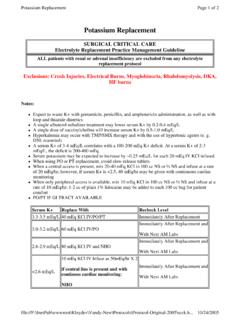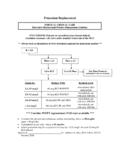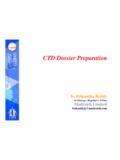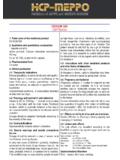Transcription of Guidelines for sedation-final - traumaburn.com
1 Guidelines for sedation , analgesia and neuromuscular blockade in the Intensive Care Unit Introduction Sedatives and analgesics are the most commonly administered medication in both surgical and medical ICU accounting for 10- 15% of the total drug costs. Despite JCAHO mandates and available Guidelines , inadequate or excessive sedation and analgesia still is common in intensive care units. Failure to meet goals of proper sedation and analgesia have deleterious sequele that are associated with an increase in adverse events, poor outcomes, longer ICU stays and economic effects. Recent studies have shown better outcomes and cost savings using protocol driven sedation and analgesia Guidelines .
2 Patients who were woken up on a regular basis during their ICU stays had lesser days on ventilators. Use of tools such as the Ramsay sedation scale as well as the Visual Analog Scale(VAS) and the FACES scale for pain have made titration of drugs more precise and cost effective In an attempt to improve sedation and analgesia in our ICU patients, thereby improving patient outcome and costs the following Guidelines have been created. These Guidelines are based on recommendations developed by the Society of Critical Care Medicine ( January 2002) combined with data on the pharmacodynamics and pharmacokinetics of the drugs in the critically ill We will use the Ramsay sedation scale or the Richmond Agitation sedation Scale (RASS) and the VAS and FACES scale for pain assessment Ramsay Scale sedation level Description 1 Anxious and agitated 2 Cooperative, tranquil, oriented 3 Responds only to verbal commands 4 Asleep with brisk response to light stimulation 5 Asleep without response to light stimulation 6 Non responsive Richmond Agitation sedation Scale (RASS)
3 Target RASS RASS Description + 4 Combative, violent, danger to staff + 3 Pulls or removes tube(s) or catheters; aggressive + 2 Frequent nonpurposeful movement, fights ventilator + 1 Anxious, apprehensive , but not aggressive 0 Alert and calm - 1 awakens to voice (eye opening/contact) >10 sec - 2 light sedation , briefly awakens to voice (eye opening/contact) <10 sec - 3 moderate sedation , movement or eye opening. No eye contact - 4 deep sedation , no response to voice, but movement or eye opening to physical stimulation - 5 Unarousable, no response to voice or physical stimulation Visual Analog Scale (VAS) no pain 0 10 worst pain FACES Scale ANXIOLYTICS AND SEDATIVES Lorazepam is a benzodiazepine of intermediate duration of action and may be administered as an infusion or by intermittent bolus injection.
4 Like other benzodiazepines, it has anticonvulsant properties. Given its terminal elimination half-life (10-20 hr), it is the benzodiazepine of choice for prolonged sedation . An advantage is no change in elimination half-life in renal disease. It is still prudent to decrease lorazepam doses in the patient with liver disease. Recent studies have however shown a prolonged duration of sedation in critically ill patients on long term lorazepam infusion as compared to a midazolam infusion. Hence lorazepam may be the sedative of choice only when liver or renal dysfunction is present Midazolam is a short-acting, hydrophilic benzodiazepine that becomes a lipophilic compound in the blood.
5 It is metabolized in the liver to alpha - hydroxymidazolam which has some sedative activity. Accumulation of the parent drug and its metabolite can produce a longer than expected duration, particularly in critical illness or hepatorenal dysfunction. Propofol is an alkylphenol which is formulated in 10% Intralipid . It is properly classified as an anesthetic, as it does not possess the ceiling effect of the above sedatives. Therefore, it is more appropriately used to sedate intubated, mechanically ventilated patients. In those patients who are ready to do so, it allows more rapid weaning from the mechanical ventilator than benzodiazepines due to its short duration of action and lack of accumulation.
6 For the same reasons, of all currently used sedatives it can most easily be titrated to a desired level of consciousness. At anesthetic doses, it can cause hypotension secondary to vasodilation and, to a lesser degree, direct myocardial depression. Although a cerebral vasodilator, propofol reduces intracranial pressure and has anticonvulsant properties; it may provide cerebral protection in the head-injured patient providing hypotension is avoided. Its formulation in Intralipid mandates that intravenous tubing be changed every day, that strict aseptic technique be adhered to in handling the drug, that preferably a dedicated infusion port be utilized and that total parenteral nutrition be adjusted for lipid content.
7 Dexmedetomidine (Precedex) is a selective alpha-2 receptor agonist that has sedative, analgesic and anesthetic properties when given as a slow infusion. It undergoes rapid distribution, the distribution half life being only 6 minutes. It is indicated for short term sedation in the ICU. It has no respiratory depression and so can be used for hemodynamically unstable patients, or for patients who need sedation for a short period but cannot afford to have respiratory depression. A bolus of 1mcg/kg is given over 10 minutes followed by an infusion of mcg/kg/hr. ANTIDELERIUM DRUGS Haloperidol is a useful drug for the treatment of delirium. Agitation in the ICU is frequently a manifestation of delirium and may respond well to haloperidol.
8 Thus, haloperidol should be used as a first line agent when agitation is thought unrelated to pain or anxiety. It is particularly safe in non-intubated patients because it rarely causes respiratory depression. It may cause exacerbation of parkinsonism and should be used with caution when combined with other centrally acting antidopaminergics, including metoclopramide. Haloperidol causes QT prolongation, which may be exacerbated in the presence of class III antiarrhythmics, hypocalcemia and intracranial hypertension. It is a mild alpha - adrenergic antagonist. Its safety has been questioned in acute head injury, as animal studies suggest worsening of secondary brain injury by the central antidopaminergic effect.
9 ANALGESICS Morphine is suitable when given by infusion or patient-controlled intravenous analgesia. It is particularly appropriate when administered by infusion over several days, because of its relatively low volume of distribution and rapid hepatic clearance. However, caution is exercised in the patient with renal insuffiency. as its water-soluble metabolites (morphine 3- and 6-glucuronide) have analgesic efficacy and are dependent on renal elimination. Fentanyl possesses one-hundred times the potency of morphine, but has similar efficacy. Because of its high lipophilicity, it is rapidly acting and widely distributed. It has high accumulative potential secondary to both its high volume of distribution and slow hepatic clearance.
10 As a result, its half-life increases progressively from 30 minutes to 9-16 hrs with continuous infusion, and care must be taken to adjust infusion rate with time. Fentanyl is suitable for patients with morphine allergy and established renal insufficiency. Unlike morphine, it does not cause histamine release and is purported to afford greater hemodynamic stability as a result. However, all sedatives and analgesics cause hypotension usually by sympatholysis, and must be used with caution in those patients with hypovolemia, cardiac failure and cardiac tamponade. PHARMACOLOGY OF NEUROMUSCULAR-RECEPTOR BLOCKERS Pancuronium. Pancuronium, one of the original NMBAs used in ICUs, is a long-acting, nondepolarizing compound that is effective after an intravenous bolus dose of mg/kg for up to 90 it is commonly given as an bolus, it can be used as a continuous infusion by adjusting the dose to the degree of neuromuscular blockade that is desired.









